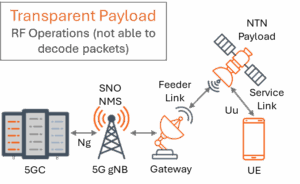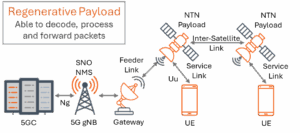With the build-out of 5G still underway and 6G some years in the future, 3GPP Release 18 provides an evolutionary step forward with the first 5G Advanced (5.5G) standard. Release 18 enhances performance, efficiency, and flexibility to support new capabilities for subscribers and improve operations for mobile network operators (MNOs). Lawful intelligence platforms must accommodate significant changes to network environments, especially at the edge. The standard also makes far more robust location intelligence possible, down to the centimeter range of accuracy.

In the interim before 6G standards are finalized, 5G Advanced will better prepare networks for emerging high-bandwidth content such as extended reality, ultra-low latency usages such as autonomous vehicles, and massive connectivity for the internet of things (IoT). It embraces and integrates AI and machine learning to more fully automate network orchestration and control, improving the network’s ability to self-regulate by spinning resources up and down more intelligently. The SS8 platform is abreast of these changes, to maintain and improve lawful intelligence capabilities as networks adopt the new standard.
Integration with More Dynamic, Automated Networks
Modern service-based architectures play a central role in optimizing networks, spinning up virtual functions on demand to improve network-capacity utilization and quality of service while reducing backhaul requirements. 5G Advanced increases the granularity of network slicing, which together with increased automation makes the software-defined network even more dynamic, and lawful intelligence tools must match that pace. Unlike monolithic cloud-based platforms, SS8’s microservices-based architecture allows it to continuously map the network and immediately spin up mediation instances where they are needed, using Helm charts. This visibility and agility ensures successful interception in challenging circumstances such as when a UPF instance is only briefly instantiated far out on the network edge.

Another 5G Advanced topology change is extended non-terrestrial network (NTN) support, connecting endpoints to mobile networks via low-altitude satellites and uncrewed aerial vehicles (UAVs). Newer generations of mobile handsets can use this interoperability to connect from areas where coverage is otherwise limited or nonexistent. The satellite itself downlinks to a ground station operated by the satellite provider, which connects to the network core through a secure internet tunnel. New standards provide seamless handover for satellite backhaul, adding new segments to the network with standards-based mechanisms that lawful intelligence systems must evolve to accommodate.

The transition to 5G Advanced is accompanied by development and improvement of other standards that improve lawful interception, handoff, and monitoring. For example, definition of the H1 interface for warrant exchange under ETSI Technical Specification 103 120, not widely implemented when it was released in 2016, has been streamlined and hardened. Likewise, ETSI 103 221 standardizes X1 (provisioning), X2 (intercept-related information or IRI) and X3 (communications content or CC) interfaces to reduce processing overhead and keep up with bandwidth requirements as throughput increases. These advances have all contributed to the SS8 lawful intelligence roadmap.
Enhanced Accuracy, Reliability, and Efficiency for Location Services
Standardization improves multi-radio access transition, such as better coordinating handover between 4G, 5G, and Wi-Fi networks, which directly benefits location intelligence. Release 18 continues the trend of network-based location accuracy improving more rapidly than that of device-based methods. Before 5G, device-based positioning technologies such as A-GNSS were dramatically more accurate than network-based ones including Enhanced Cell ID, timing advance, and LTE OTDOA. Because device-based positioning is generally restricted to emergency services use (in addition to its line-of-sight limitations), law enforcement agencies (LEAs) generally lacked access to high-accuracy location data.
With 5G network-based positioning, LEAs gained capabilities for high-accuracy location, the precision of which is further increased to the centimeter or even millimeter level with 5G Advanced networks. While widespread MNO adoption of Release 18 is still some years in the future, the standard specifies several enhancements to network-based positioning that will help define the location intelligence field later in the present decade, including the following:
- Carrier-phase positioning measures phase changes in carrier signals to achieve sub-centimeter accuracy. 5G Advanced introduces native support for carrier-phase measurements within the cellular network itself.
- Bandwidth aggregation creates a new positioning framework that combines multiple frequency bands of reference signals generated by the mobile network to improve on the accuracy possible from any one signal.
- Low-power high-accuracy positioning is supported by targeted optimizations that facilitate positioning of reduced-capacity (RedCap) devices such as industrial sensors, surveillance systems, and wearable technology.
- Sidelink positioning standardizes existing methods for enhancing positioning accuracy using direct communications between devices, in a related fashion to Apple AirTags and similar products.
Network-based positioning is effective for all attached devices, unaffected by factors such as satellite visibility. In addition to law enforcement, civilian and industrial usage models such as self-driving vehicles, smart warehousing, and smart cities all benefit. Looking ahead to MNO adoption of Release 18, SS8 research and development teams are at the forefront of delivering lawful intelligence capabilities focused on the future as much as the present.
About David Anstiss

David Anstiss is Director of Solution Engineering at SS8 Networks. He has been with SS8 since 2015 and has significant experience in critical network architecture technology and advanced data analytics. He currently works as part of the Technical CTO Group under the leadership of Dr. Cemal Dikmen and is responsible for leading engagement with both intelligence agencies and Communication Service Providers (CSPs) around the world. He has been instrumental in helping them transition to 5G, defining system requirements to meet regulatory compliance. As a member of ETSI, he represents SS8 to ensure the adoption of cloud-native infrastructure is met with industry best practices and to guarantee that compliance of lawful interception is maintained. Learn more about David here on his LinkedIn profile.
About SS8 Networks
As a leader in Lawful and Location Intelligence, SS8 is committed to making societies safer. Our mission is to extract, analyze, and visualize critical intelligence, providing real-time insights that help save lives. With 25 years of expertise, SS8 is a trusted partner of the world’s largest government agencies and communication providers, consistently remaining at the forefront of innovation.
Intellego® XT monitoring and data analytics portfolio is optimized for Law Enforcement Agencies to capture, analyze, and visualize complex data sets for real-time investigative intelligence.
LocationWise delivers the highest audited network location accuracy worldwide, providing active and passive location intelligence for emergency services, law enforcement, and mobile network operators.
Xcipio® mediation platform meets the demands of lawful intercept in any network type and provides the ability to transcode (convert) between lawful intercept handover versions and standard families.
To learn more, contact us at info@SS8.com.

